
A Comprehensive Guide to the Best Ceiling Mounted Body Lifts
Why Ceiling Mounted Body Lifts Are Essential for Safe Patient Handling
A ceiling mounted body lift is a motorized lifting system that attaches to overhead tracks, allowing caregivers to safely transfer patients between beds, wheelchairs, toilets, and baths without manual lifting. These systems reduce caregiver injuries by up to 50% while providing users greater independence and dignity during transfers.
Key Benefits of Ceiling Mounted Body Lifts:
- Safety: Eliminates manual lifting and reduces fall risk
- Ergonomics: Protects caregiver backs and shoulders
- Space-saving: No floor equipment to steer around
- Independence: Users can operate lifts themselves with proper support
- Efficiency: Single caregiver can perform transfers safely
- Versatility: Works in homes, hospitals, and care facilities
Weight Capacities: Standard models handle 200-600 lbs, with bariatric systems supporting up to 800+ lbs
System Types: Fixed motors for single rooms, portable motors for multi-room use, and track systems covering entire homes or facilities
Ceiling lifts transform patient handling from a physically demanding task into a smooth, controlled process. Whether transferring a stroke survivor from bed to bathroom or helping someone with ALS maintain their daily routine, these systems provide the mechanical advantage needed for safe, dignified care.
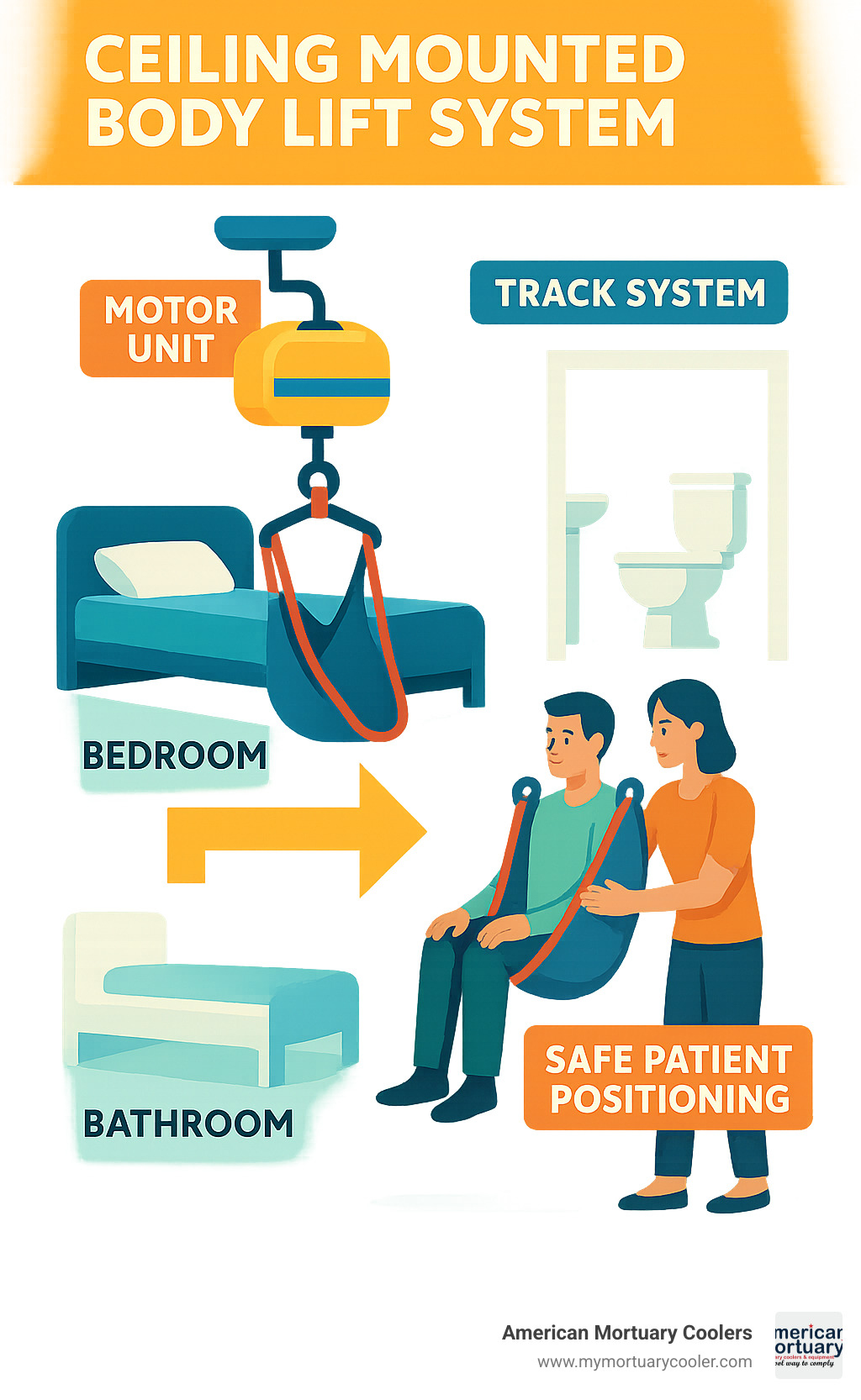
Key terms for ceiling mounted body lift:
Understanding Ceiling Mounted Body Lift Systems
A ceiling mounted body lift combines a motorized lift unit that glides along ceiling rails with handheld controls for complete command. The system uses spreader bars and body supports that cradle users safely, powered by reliable battery systems with built-in emergency stops.
What is a Ceiling Mounted Body Lift?
A ceiling mounted body lift is a motorized patient handling system that lifts people vertically and moves them horizontally along ceiling tracks. The primary purpose is eliminating manual lifting that injures caregivers while providing smooth, dignified transfers.
Weight capacities range from 200 pounds for residential use up to 1,000 pounds for heavy-duty applications. Guldmann ceiling lifts handle 175-500 kg (385-1,100 lbs), while the LikoGuard XL ceiling lift supports 800 lbs (363 kg) for bariatric patients.
How Does a Ceiling Mounted Body Lift Work?
A motorized hoist responds to wireless hand controls or infrared remotes. Users rest in slings or body support systems that attach to spreader bars, connecting securely to the lift motor through safety straps.
Modern systems feature in-rail charging for continuous power and QuickTrolley systems allowing portable motors to travel between track sections. Lithium-ion batteries provide reliable power with automatic shutoff to preserve charge.
Key Features & Components
The lift motor handles 200 to 1,000+ pounds with gentle start/stop functions and emergency lowering. Track hardware creates transfer pathways with ceiling-mounted rails in straight runs, curves, or comprehensive X-Y systems.
Spreader bars connect motor to user, available in standard or electric tilting models. The SureHands Body Support self-adjusts and locks under load while leaving bottom and back regions free for toileting.
Sling options include standard contour slings, hygiene slings for toileting, bathing slings for showers, and specialized bariatric slings. Battery systems use lithium-ion technology with In-Rail Charging for continuous power.
Safety features include emergency stop buttons, mechanical emergency descent, and backup operation capabilities.
Types of Ceiling Lifts and Body Supports
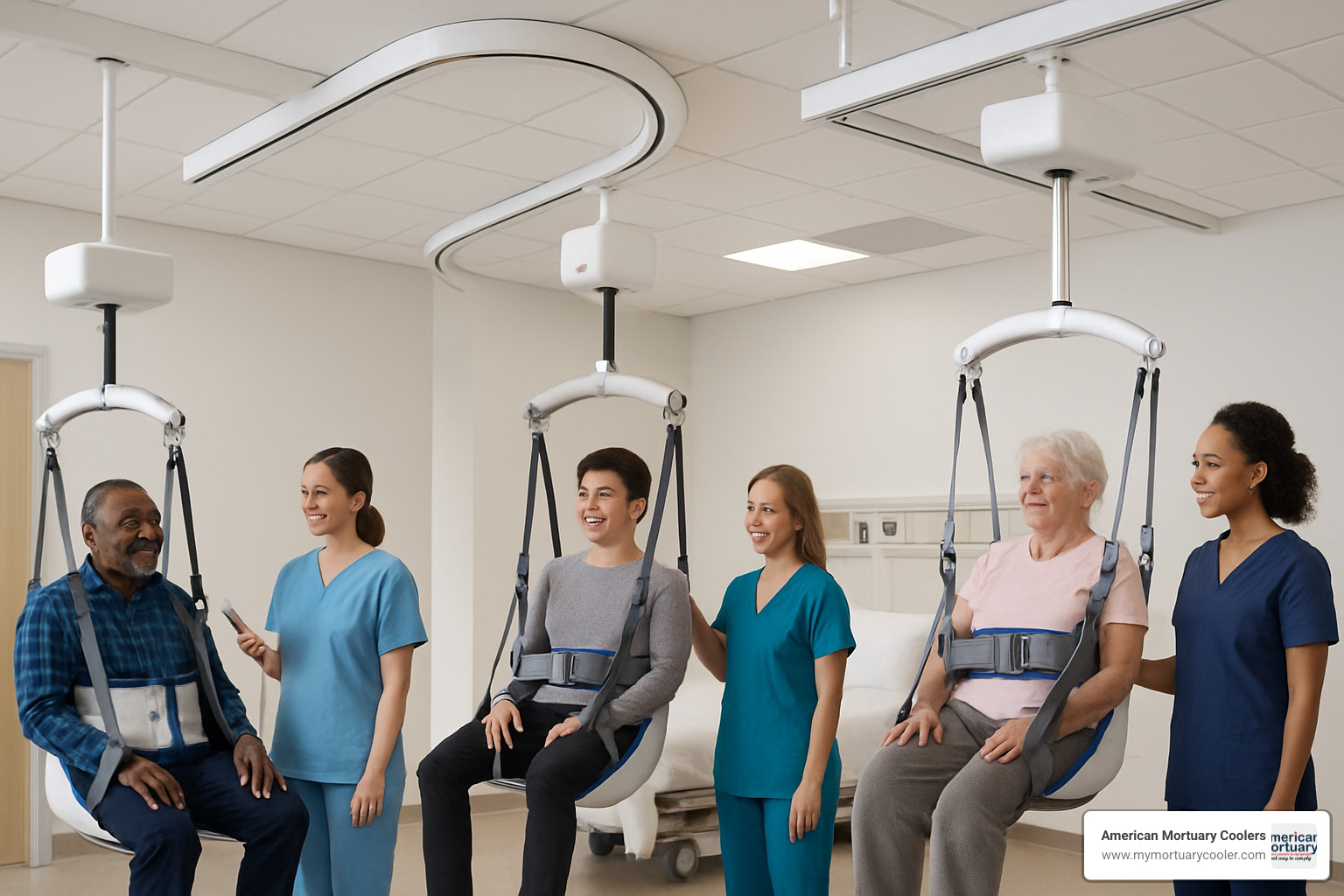
Choosing the right ceiling mounted body lift system depends on your specific needs, space, and budget. Think of it like planning a transportation network for your home or facility - some situations call for a dedicated express line, while others benefit from a flexible system that can serve multiple destinations.
The beauty of modern ceiling lift systems lies in their adaptability. You can start with a basic setup and expand over time, or design a comprehensive system that covers every transfer need from day one.
Fixed vs Portable Ceiling Mounted Body Lift
Fixed ceiling mounted body lifts are like having a dedicated elevator in each room. The motor stays permanently in one location, ready to spring into action whenever needed. These workhorses can handle the heaviest loads - up to 1,000 pounds - making them perfect for high-traffic areas like master bedrooms or primary bathrooms where multiple transfers happen daily.
The main advantage? Speed and reliability. There's no waiting or setup time, and the motor is always positioned exactly where you need it. Fixed systems also tend to be more robust, handling frequent use without missing a beat.
Portable ceiling lifts offer a different kind of freedom. One motor travels along continuous track systems, serving multiple rooms as needed. It's like having a single taxi that can pick you up anywhere along the route. These systems typically support up to 600 pounds and work beautifully for families or facilities wanting comprehensive coverage without the expense of multiple motors.
The trade-off is simple: you'll spend a few extra minutes positioning the motor before each transfer, but you'll save significantly on equipment costs. Many families find this approach perfect for covering bedrooms, bathrooms, and living areas with a single investment.
Here's the smart part - the same ceiling track infrastructure works with both fixed and portable motors. You can start with a portable system and add fixed motors to high-use areas later as your needs or budget evolve.
Track Configurations (Straight, Curved, XY)
Straight track systems are the workhorses of ceiling lifts. They excel at moving people along corridors, from bed to bathroom, or in specialized areas like pool facilities. Single-rail systems provide the most economical solution when you need reliable point-to-point transfers.
H-system configurations transform entire rooms into accessible spaces. Picture two parallel rails connected by traverse sections - this creates a grid that reaches virtually every corner of a room. Whether you're transferring from bed to dresser, bathroom to shower, or anywhere in between, the H-system provides complete freedom of movement.
Room-covering XY systems take this concept even further, creating comprehensive networks that can span multiple connected spaces. These systems shine in care facilities or large homes where seamless movement between areas is essential.
Turntables and combi-lock systems solve the puzzle of connecting different track sections. The combi-lock technology allows lifts to travel smoothly from one rail system to another - imagine moving from bedroom tracks directly onto bathroom rails without any manual intervention. Turntables provide smooth directional changes within track networks.
For unique challenges, specialized solutions exist. Pool rails support aquatic therapy sessions, corridor runs enable facility-wide coverage, and the cleverly named "Tarzan" door crossing system allows transfers through doorways without permanent track modifications - perfect for rental properties or situations where structural changes aren't possible.
Slings vs Body Support Systems
Traditional slings have served the lifting industry well, with specific designs for different situations. Universal slings handle everyday transfers, while hygiene slings feature open-bottom designs for toileting without removal. Bathing slings use quick-dry materials perfect for shower transfers, and bariatric slings provide reinforced support for users over 300 pounds.
Body support systems represent a breakthrough in lifting technology. The SureHands Body Support takes a completely different approach - instead of wrapping around the torso, it uses patented thigh supports that automatically lock under the user's weight.
This design is brilliant in its simplicity. The hinged stainless-steel mechanism adjusts to each person's body automatically. When weight is applied, the thigh supports secure the upper body position. When tension releases, the supports easily reposition for the next transfer.
The real advantage? Complete freedom for toileting, bathing, and independent use. The bottom and back regions remain completely unencumbered, maintaining dignity while providing secure support. Users don't need shoulder strength to use the system safely, making it perfect for people with conditions like ALS or spinal cord injuries.
Whether you choose traditional slings or modern body supports often comes down to the user's specific needs and independence goals. Many facilities find that having both options available provides the most comprehensive solution for their diverse population.
Safety, Ergonomics & Benefits
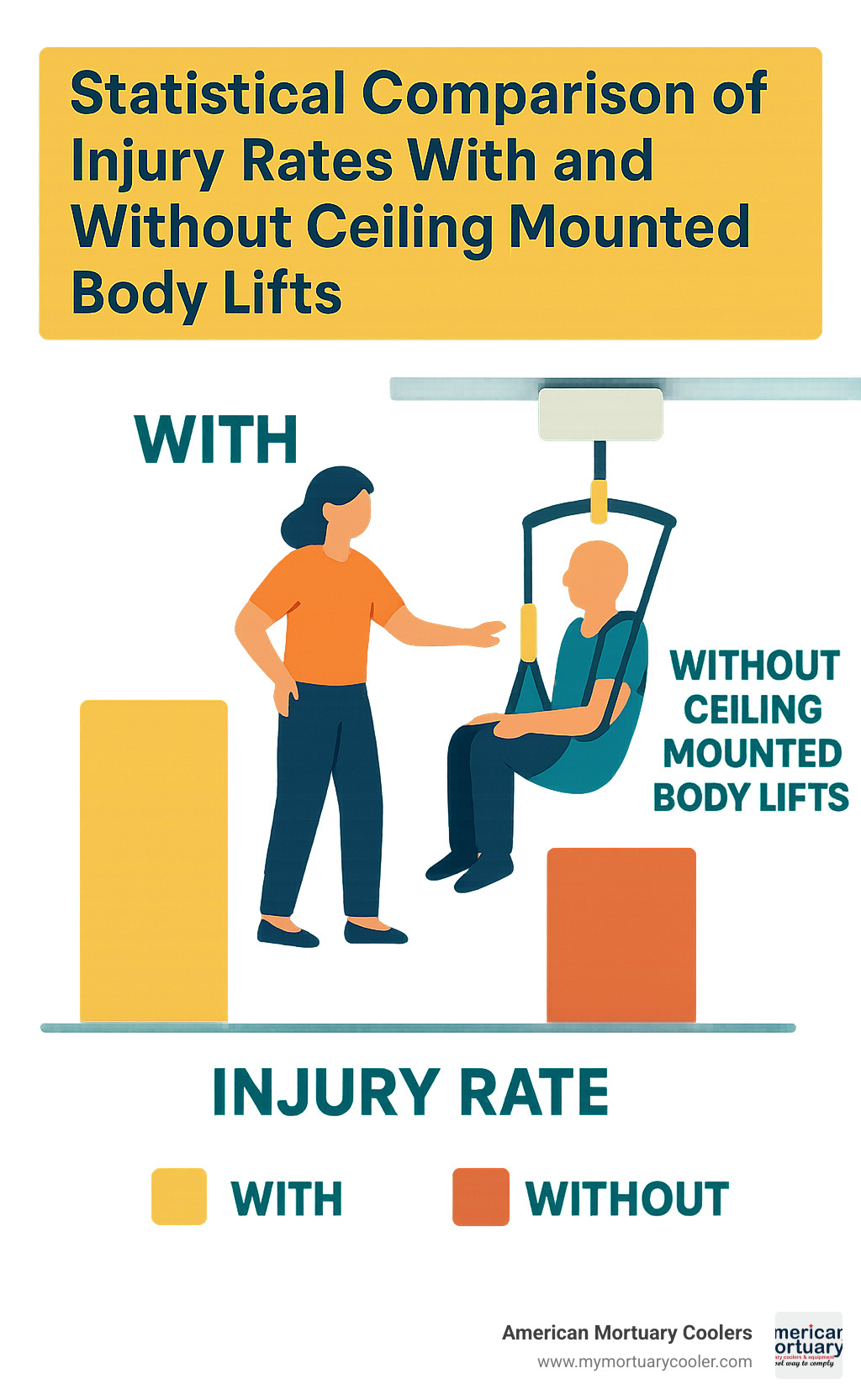
Ceiling mounted body lifts transform patient handling from strenuous manual lifting to smooth, controlled transfers. Scientific research on caregiver injury reduction shows dramatic safety improvements while giving users unprecedented independence. Facilities report transfers that are 30 minutes faster compared to traditional methods.
Reducing Caregiver Injuries with a Ceiling Mounted Body Lift
Healthcare workers face high injury rates from manual patient lifting. Ceiling mounted body lifts eliminate musculoskeletal strain entirely, allowing caregivers to maintain upright postures while controlling mechanical transfers.
The 50% injury reduction in facilities using ceiling lift programs represents real people avoiding career-ending back injuries. OSHA's safe-patient-handling guidelines specifically recommend mechanical lifting devices, with benefits including reduced sick leave, higher job satisfaction, and lower workers' compensation costs.
User Independence and Quality of Life
Users with adequate arm and hand function can operate ceiling mounted body lifts independently, controlling their own transfers throughout the day. This independence preserves dignity and autonomy beyond the mechanical transfer itself.
The SureHands Body Support system excels here because it doesn't require shoulder strength that traditional slings demand. Users can position themselves and operate lift controls for self-operated transfers, maintaining control over daily routines and privacy during personal care.
Comparison with Floor Lifts & Mobile Hoists
| Feature | Ceiling Mounted Body Lift | Floor/Mobile Lifts |
|---|---|---|
| Floor Space | No footprint - saves space | Requires storage and maneuvering space |
| Setup Time | Always ready - no setup | Must be positioned for each use |
| Staffing | Single caregiver operation | Often requires two caregivers |
| Transfer Speed | 30 minutes faster per transfer | Slower due to positioning requirements |
| Room Coverage | Can cover entire rooms | Limited to lift base footprint |
| Maintenance | Minimal - overhead location | Higher - floor-level wear and tear |
Ceiling systems provide time savings that add up quickly, making the difference between adequate care and exceptional care while protecting staff from physical demands.
Installation, Capacity & Maintenance Essentials
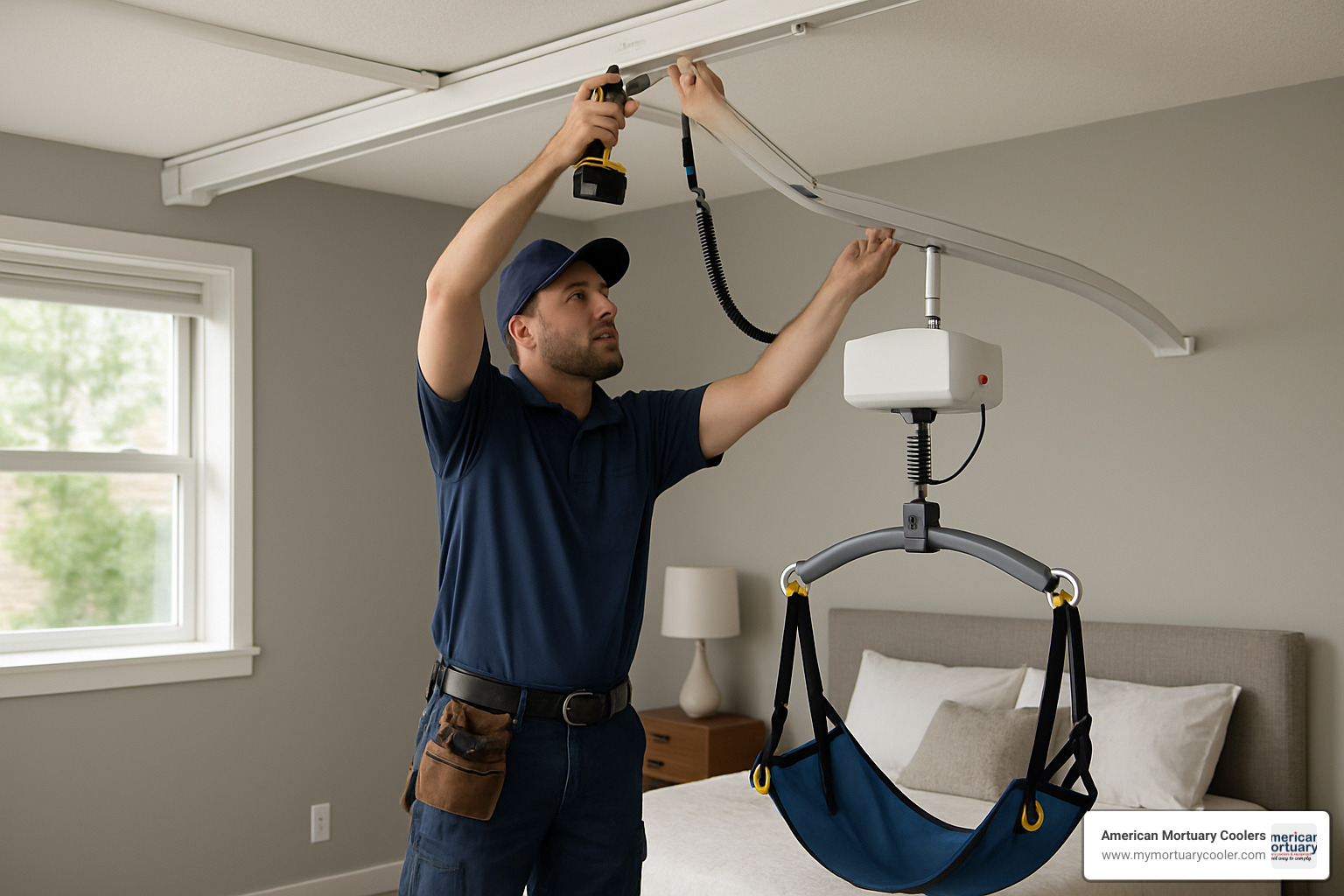
Installing a ceiling mounted body lift typically takes less than a day with professional installation. The process involves structural assessment, joist reinforcement if needed, and electrical connections for charging systems.
Structural Requirements & Home Retrofit Possibilities
Most homes can accommodate ceiling lift systems with proper structural evaluation. The main concern is whether ceiling joists can handle both lift motor weight and dynamic forces during transfers.
Retrofit solutions include joist reinforcement to distribute loads, freestanding gantry systems that don't rely on existing ceilings, and wall-mounted brackets for alternative mounting. Portable track systems minimize permanent modifications for renters.
Professional installers perform load calculations accounting for user weight, lift motor, and dynamic forces, ensuring everything meets building codes and safety standards.
Weight Capacities & Technical Specs
Standard residential systems handle 200-440 pounds with lift speeds of 2.3 inches per second. Heavy-duty systems support 550-800 pounds for bariatric applications. Ultra-heavy systems for specialized applications like mortuary use handle 1,000+ pounds with dual-motor configurations.
Most systems offer lifting intervals of 80+ inches vertical travel, with battery life supporting 80-160 lifts per charge. Portable motors typically weigh 15-25 pounds.
Routine Maintenance & Servicing
Monthly maintenance involves visual checks of tracks and mounting hardware, testing emergency functions, checking battery levels, and inspecting slings for wear. Clean tracks regularly and test hand controls for reliable operation.
Annual professional inspections include structural assessments, electrical testing, motor performance evaluation, track alignment verification, and safety system testing. Battery maintenance with lithium-ion systems is straightforward, with standard ground shipping details for replacements typically requiring 3-5 year intervals.
Service contracts often include battery replacement and annual inspections, taking guesswork out of maintenance scheduling.
Choosing the Best Ceiling Mounted Body Lift for Your Needs
Finding the right ceiling mounted body lift involves considering who will use the system, installation location, and funding options.
Cost, Funding & Insurance Paths
Basic systems start around $7,000 to $9,000 plus installation. Multiple-room coverage runs $8,000 to $14,000. Independent lifts with body support range $9,000 to $11,000 for single rooms, $12,000 to $18,000 for multi-room setups. Complex whole-home systems can reach $15,000 to $25,000.
Funding options include Medicare and Medicaid waivers (varies by state), Veterans Affairs coverage for qualifying veterans, Workers' Compensation for work-related injuries, and private insurance when prescribed as durable medical equipment. Leasing options spread costs over 2-5 years, while facilities see return on investment through reduced workers' compensation claims.
Special Applications: Bariatric, Pediatric, Rehabilitation & Mortuary
Bariatric applications require systems with improved weight capacities and twin motor configurations for users over 400 pounds. Pediatric users need specialized harnesses, while rehabilitation settings enable gait training and therapy exercises.
Mortuary applications require ultra-high weight capacities and hygienic design. The M675 Electric Ceiling Mounted Lift handles up to 1,000 pounds with integrated load scales and halogen lighting for funeral homes. These systems feature hygienic fiberglass construction, integrated weighing capabilities, and specialized straps designed for mortuary use. Maximize Safety with American Mortuary's Durable Crematory and Mortuary Lift Solutions offers comprehensive details.
Design Integration & Customization Options
Modern systems don't have to look like medical equipment. Color-matched rails complement interior design, recessed track systems minimize visual impact, and decorative covers hide functional components.
Smart integration includes magnetic stops for precise positioning, programmable controls for preferred settings, and smart home integration for voice control. Custom track configurations work around architectural constraints with curved tracks and specialized mounting systems.
Frequently Asked Questions about Ceiling Mounted Body Lift Systems
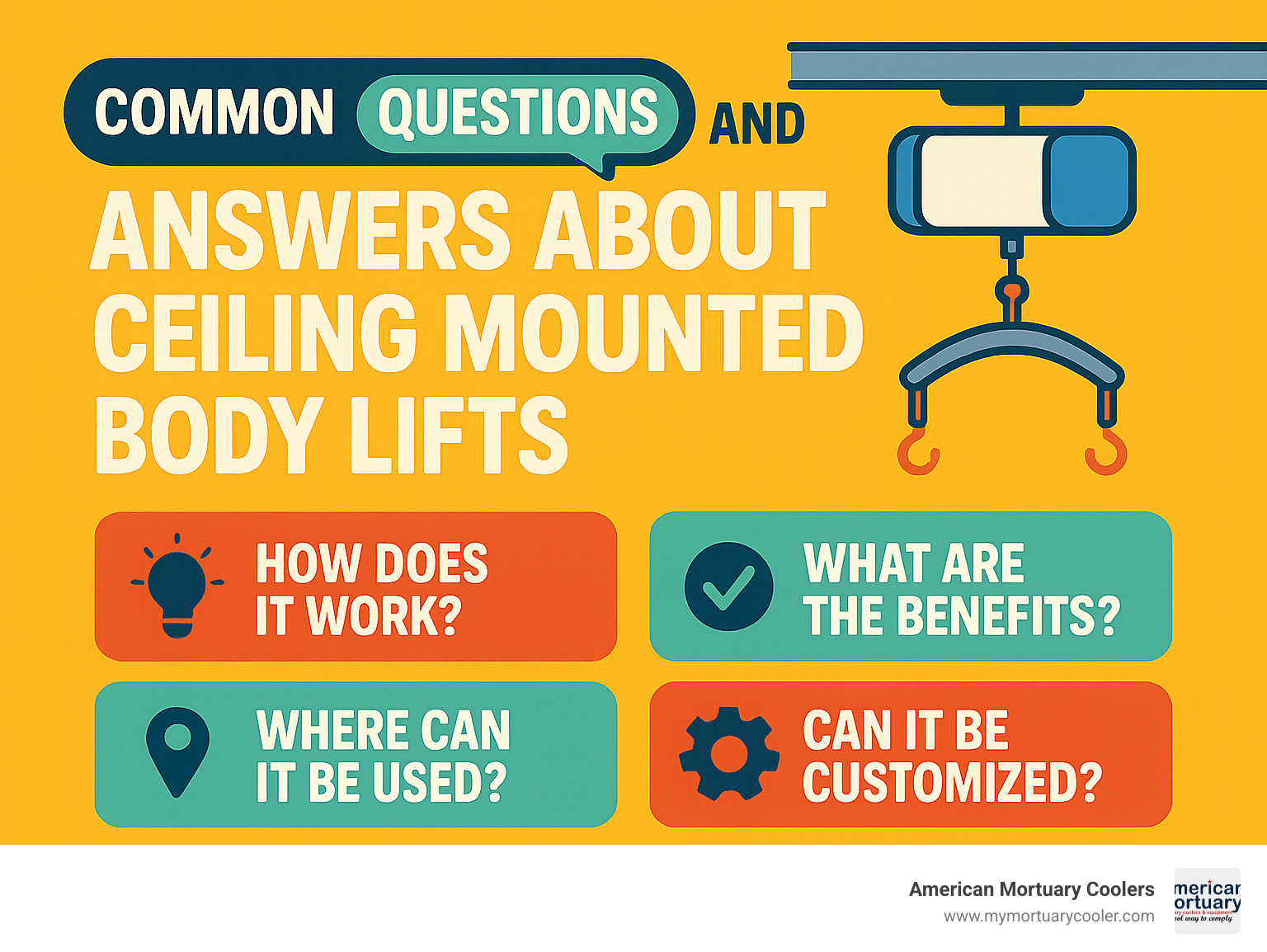
What Funding Options Exist for Ceiling Mounted Body Lifts?
Medicare coverage is possible when physicians prescribe ceiling lifts as medically necessary durable medical equipment. Medicaid waivers through home and community-based services vary by state. Veterans Affairs programs provide excellent coverage for qualifying veterans through adaptive equipment benefits.
Workers' compensation coverage applies when mobility limitations result from workplace injuries. Private insurance policies handle ceiling lifts differently, but many cover them when properly prescribed. Financing options from suppliers spread costs over 2-5 years, making systems more accessible.
Can a Ceiling Mounted Body Lift Be Moved If I Relocate?
Ceiling mounted body lifts can be relocated with professional planning and reinstallation. Track systems can be disassembled and reinstalled in new homes, provided ceiling structure can handle loads. Portable motor systems make relocation easier since expensive motor components attach to new track installations.
Freestanding gantry systems offer ultimate portability since they don't require ceiling mounting. Relocation typically costs less than purchasing completely new systems.
How Do Emergency Procedures Work During a Power Failure?
Mechanical emergency descent systems allow safe lowering when electrical power is lost. Battery backup provides substantial emergency capacity with 80-160 lifts per charge. Emergency stop buttons immediately halt movement, while backup operation systems provide alternative control methods.
The scientific research on caregiver injury reduction demonstrates how ceiling lift systems include comprehensive safety features that make them safer than manual transfers, even during emergencies. Manual override capabilities ensure safe lowering using mechanical advantage rather than electrical power.
Conclusion
Ceiling mounted body lifts represent one of the most meaningful advances in care technology, restoring dignity, preventing injuries, and providing confidence in safe transfers. These versatile systems adapt to virtually any need, from simple portable systems to complex multi-room installations, with weight capacities from 200 pounds to over 1,000 pounds.
The results speak for themselves: up to 50% reduction in caregiver injuries, single-person transfers, and 30 minutes time savings per transfer. Beyond statistics, these systems help people regain independence through reliable technology.
At American Mortuary Coolers, our experience with specialized mortuary equipment has taught us that reliability isn't just a feature—it's everything. We bring the same commitment to quality and durability to ceiling mounted body lift solutions that our mortuary coolers have earned across the funeral industry.
Our direct delivery service across the contiguous 48 states provides professional-grade equipment without delays. Most orders process within 24 hours and ship within 48 hours, because when you need lifting solutions, you need them now.
The investment in quality ceiling lift systems pays for itself through reduced workers' compensation claims, lower sick leave costs, and something priceless: caregivers who go home without aching backs, and patients who maintain dignity during vulnerable moments.
As healthcare evolves toward safer, more efficient patient handling, ceiling lifts are becoming essential. The question isn't whether to invest in this technology, but which system serves your needs best.
Ready to explore how a ceiling mounted body lift can transform your care environment? Improve your workflow with our full mortuary lift range and find how American Mortuary Coolers provides custom lifting solutions that deliver safety and peace of mind.



